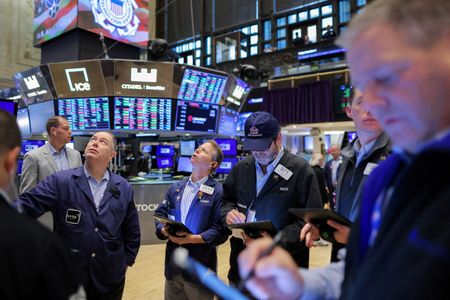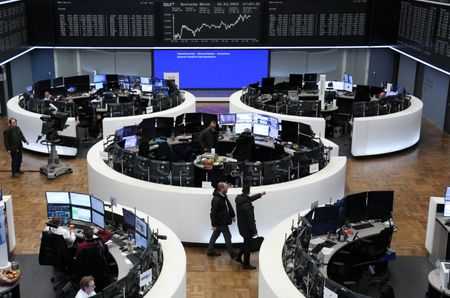


By Lawrence Delevingne and Elizabeth Howcroft
(Reuters) -Wall Street stocks posted strong gains while Treasury yields and the dollar pulled back on Friday as data pointing to economic growth boosted risk appetite, even as expectations for rate hikes kept bond yields near multi-year highs.
The U.S. services sector grew at a steady clip in February, with new orders and employment rising to more than one-year highs, suggesting the economy continued to expand in the first quarter.
The Dow Jones Industrial Average rose 0.85%, to 33,282.81, the S&P 500 gained 1.26%, to 4,031.54, and the Nasdaq Composite added 1.56%, to 11,641.85.
“Our overall view is still more consistent with slow disinflation amid some further improvement to global growth,” Goldman Sachs market strategists wrote in a note late Thursday. “That mix should maintain the upward pressure on yields but ultimately limit the damage to equities and provide an overdue tailwind to commodities.”
Stock markets gained in Asian trading, with investors optimistic about signs of a Chinese economic rebound. Activity in China’s services sector expanded at the fastest pace in six months in February, driving a solid increase in employment, a PMI survey showed.
The positive market sentiment continued during the European session, with Europe’s STOXX 600 up 0.92%.
The recovery in euro zone business activity gathered pace last month, PMI survey data showed, in the latest piece of data to suggest the bloc would avoid a recession.
But euro zone government bond yields were still near their highest levels in years after euro zone inflation data on Thursday drove market expectations for the European Central Bank’s (ECB) terminal rate to around 4%.
Estonian central bank chief Madis Müller made the case for further ECB rate hikes on Friday, while ECB Vice President Luis de Guindos warned of persistent inflation.
At 2.703%, the benchmark 10-year German yield was near its highest level since 2011 and on track for its biggest weekly rise since December.
U.S. Treasury yields paused their rally. The U.S. 10-year Treasury yield fell to 3.971%, down from Thursday’s high of 4.091%. The two-year Treasury yield, which typically moves in step with interest rate expectations, dipped 3.5 basis points at 4.869%.
Investors are trying to gauge the path for Federal Reserve rate hikes, after strong U.S. data in recent weeks suggested rates may need to be higher for longer.
Bill Sterling, global strategist at GW&K Investment Management in Boston, said the small differential between shorter-term bonds, known as the “near-term forward spread,” indicated a lower risk of recession.
“Market participants seem to be saying that the economy – and corporate profits – can withstand a higher-for-longer interest rate path,” Sterling said.
The MSCI world equity index, which tracks shares in 47 countries, jumped 1.25% on the day, up 5.6% for the year.
The euro ticked up 0.24% on the day, while the U.S. dollar was down 0.33% against a basket of currencies.
Analysts polled by Reuters were unfazed by the dollar’s recent strength, up about 7% over the last 12 months, and predicted a weaker greenback in a year amid an improving global economy and expectations the Fed will stop hiking interest rates well ahead of the ECB.
U.S. crude rose 1.83% to $79.59 per barrel and Brent was at $85.80, up 1.24% on the day.
Spot gold added 0.7% to $1,848 an ounce.
Cryptocurrencies suffered as the crisis engulfing crypto-focused bank Silvergate Capital Corp worsened. Bitcoin was down nearly 5% at around $22,383, its lowest price since Feb. 15.
(Reporting by Lawrence Delevingne in Boston and Elizabeth Howcroft in London; Editing by Alexander Smith, Shounak Dasgupta, Angus MacSwan, Alex Richardson and Leslie Adler)

